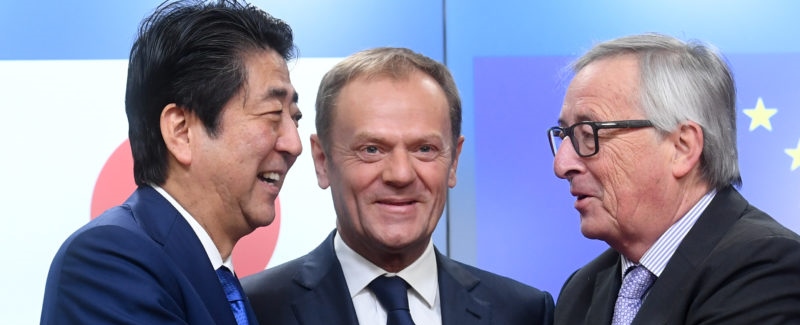Japan-EU trade deal
July 18, 2018 | Expert Insights

Japanese Prime Minister Abe met with European Commission President Jean-Claude Juncker and European Council President Donald Tusk in Tokyo to sign the “Economic Partnership Agreement” at the 25th EU-Japan Summit.
Background
The Japan- EU relations dates back to 1959, when the Japanese ambassador in Belgium was the first representative to the European Communities.In 1984 the first ministerial meeting between the two sides took place. In 1987, The Japanese government (METI) and the European Commission established the EU-Japan Centre for Industrial Cooperation. It was aimed at enhancing all forms of industrial, trade and investment cooperation between both the countries.
On July 18, 1991, Japanese Prime Minister Kaifu signed a joint statement with the Dutch prime minister and others, pledging closer Japanese-European Community consultations on several matters. The Japanese government hoped that this agreement would help to broaden Japanese-European Community political links and raise them above the narrow confines of trade disputes.
The EU and Japan account for about a quarter of the world’s GDP.The total trade volume of goods and services between the EU and Japan is €86 billion. The trade relationships between the EU and Japan have usually been characterised by big trade surpluses in favour of Japan. Recently, trade figures have become more balanced, but Japan continues to be a country where doing business or investing is often challenging due to the features of their economy and society.
In 2013 EU governments instructed the European Commission to start negotiations with Japan. On 6 July 2017 the EU and Japan reached an agreement in principle on the main elements of the EU-Japan Economic Partnership Agreement.On 8 December 2017, the negotiations were finalised.
Analysis
The European Union and Japan signed a widespread trade deal that will eliminate nearly all tariffs, seemingly defying the worries about trade tensions set off by Trump's policies.The ceremonial signing on Tuesday was delayed from earlier this month as PM Abe cancelled his Brussels trip over a disaster in southwestern Japan.
According to the European Commission, the EU-Japan "Economic Partnership Agreement" (EPA) is the largest trade deal ever negotiated by the EU and will create a trade zone covering 600 million people and nearly a third of global GDP.The EU has called the agreement "highly ambitious and comprehensive."
The deal offers high expectations for agriculture. The prices of European wine and pork will fall for Japanese consumers. Japanese machinery parts, tea and fish will get cheaper for Europe. According to the Commission, exports of processed foods could increase by up to 180 %.The EPA will also open the Japanese market for more EU-based services and give EU developers access to Japanese public infrastructure projects, such as railroads.
The EPA is also expected to increase chemical exports from the EU to Japan by 22 % and mechanical engineering shipments by 16 %. The Japanese computer, electric and automobile industries are all expected to benefit from the deal. For instance, EU import tariffs on Japanese cars, currently at 10 percent, will gradually be reduced to zero.
German companies doing business in Japan will benefit from this deal, as the number is expected to grow by double- digit percentage in the coming years. "The free trade agreement will infuse a new dynamic for business relations on both sides," said Marcus Schürmann, director of the German Chamber of Commerce in Japan (AHK Japan). German companies are enthusiastic to enter Japanese market sectors that were earlier closed for German investment.
The EU and Japan also see the signing of the deal as a signal of protest against Trump's protectionist trade policies. PM Abe views free trade as a driver of Japanese economic growth. The EU and Japan accelerated their negotiations after Trump pulled the US out of the Trans-Pacific Partnership agreement.
The EU commission responded to warnings from consumer advocates saying that the agreement will not lead to deregulation and privatization of water and sanitation. They said that, Japan and the EU want to meet the highest standards of work, safety, environmental and consumer protection.
Counterpoint
The EU-Canada Comprehensive Economic and Trade Agreement (CETA) in 2016, experienced widespread protests threatening to destroy the deal. The fact that Japan’s population is nearly four times greater than Canada’s, and that JEFTA would cover nearly a third of world market activity, are a cause of increasing concern among critics.
According to Powershift, an organisation critical of globalisation, JEFTA “shows all the bad traits of TTIP and CETA”. Free-trade-critical network S2B said in a joint statement signed by dozens of NGOs that JEFTA risks being a substitute for TTIP.
Assessment
Our assessment is that the Japan-EU EPA, although rushed due to Trump’s policies, provides a beneficial trade deal in terms of the agriculture and manufacturing sector.We feel that Japan and EU must establish an institution to resolve investor disputes resulting from this deal. We believe that the deal should be mindful of consumer and environmental concerns. We also believe that with trade deals in Singapore, China and now in Japan, EU is moving closer to Asia in a Trump protectionist era.








Comments